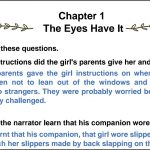The story The Eyes Have It by Ruskin Bond explores a chance meeting between two passengers in a train compartment, both hiding a secret about their blindness. The story emphasizes perception and the importance of sight, both literal and metaphorical. Below are long questions and answers to dive deeper into the themes, characters, and elements of the story.
The Eyes Have It Long Question Answer:
Question: How does Ruskin Bond highlight the theme of perception in The Eyes Have It?
Answer:
Ruskin Bond highlights the theme of perception in The Eyes Have It through the interactions between the two blind characters, who are unaware of each other’s blindness. The protagonist tries to create an image of his co-passenger by asking about her appearance and listening to her voice. He tries to perceive her beauty not through his sight but through her words and tone. The woman, on the other hand, seems to be oblivious to the fact that the protagonist is also blind, which adds to the irony of the situation. Both characters create imaginary versions of each other based on limited senses, which underscores the idea that people often perceive others not as they are, but as they imagine them to be. This highlights the gap between reality and perception in human interaction.
Question: What role does irony play in The Eyes Have It?
Answer:
Irony plays a crucial role in The Eyes Have It, as both main characters are blind but are unaware of the other’s blindness throughout their conversation. The protagonist assumes that his blindness is unnoticed by the girl and goes to great lengths to hide it, creating an illusion of sight. He carefully constructs his responses to seem as though he can see the world around him. Similarly, the girl gives no indication that she is blind. This creates dramatic irony, where the reader knows something that the characters do not. The story ends with an unexpected twist when the narrator learns from another passenger that the girl, too, was blind. The irony emphasizes the theme of perception and how humans rely on limited information to judge others, often leading to false conclusions.
Question: Describe the narrator’s feelings when he first meets the girl in the train.
Answer:
The narrator is intrigued and curious when he first meets the girl in the train. Though blind, he attempts to create a mental image of her, using her voice and the sound of her movements to guess what she looks like. He is captivated by her soft, pleasant voice and imagines her to be beautiful. As they begin their conversation, the narrator feels a mix of excitement and nervousness. He becomes conscious of his blindness and is determined to conceal it from the girl, carefully choosing his words and actions to maintain the illusion that he can see. His curiosity about her appearance grows as the conversation progresses, and he feels a strong desire to know more about her. This initial meeting sets the tone for their brief but meaningful interaction.
Question: How does the author use sensory details to enhance the story, despite both characters being blind?
Answer:
Despite both characters being blind, Ruskin Bond uses rich sensory details to enhance the narrative in The Eyes Have It. Since the protagonist cannot rely on sight, he describes the world around him through sound, smell, and touch. For example, he pays close attention to the rustling of the girl’s clothes, the scent of the perfume she wears, and the sound of her voice. These sensory details create a vivid image of the environment and the characters, allowing the reader to experience the story through senses other than sight. Bond’s use of sensory language helps the reader understand the protagonist’s experience of the world and makes the absence of sight less noticeable. It also deepens the story’s themes of perception, emphasizing that understanding and interpreting the world goes beyond just seeing it.
Question: What is the significance of the story’s title, The Eyes Have It?
Answer:
The title The Eyes Have It is significant as it emphasizes the theme of sight and perception, which is central to the story. Both the protagonist and the girl are blind, yet their conversation revolves around the idea of seeing. The protagonist attempts to hide his blindness and constructs an imaginary vision of the girl based on her voice and scent. The irony of the title lies in the fact that neither character has the ability to see, but their interaction is filled with references to vision and appearance. The title suggests that even though their eyes do not function, their perceptions of each other and the world are shaped by other senses and their imagination. The story ultimately reveals that true perception goes beyond physical sight, and the title reflects this deeper meaning.
Question: Discuss the character of the narrator in The Eyes Have It.
Answer:
The narrator in The Eyes Have It is an introspective and sensitive character, deeply aware of his blindness but determined to conceal it from others. He is intelligent and perceptive, carefully crafting his words and responses to give the impression that he can see. Throughout the story, the narrator is intrigued by the girl he meets on the train, and he goes to great lengths to imagine what she looks like based on her voice, scent, and movements. His introspection is evident in the way he reflects on human interaction and the nature of perception. Despite his blindness, he shows a strong desire to connect with the world and other people. The narrator’s internal conflict—his desire to appear normal despite his disability—adds depth to his character and makes him relatable to the reader. His witty and thoughtful observations also provide insight into his personality, revealing a man who is both lonely and yearning for connection.
Question: What is the turning point in the story The Eyes Have It?
Answer:
The turning point in the story The Eyes Have It occurs when the girl gets off the train, and the narrator reflects on their conversation. Up until this point, the narrator has been deeply engaged in the interaction, trying to hide his blindness while also attempting to imagine what the girl looks like. However, after she leaves, another passenger enters the compartment and casually mentions that the girl was blind. This revelation comes as a shock to both the narrator and the reader, as it exposes the dramatic irony that has been present throughout the story. The turning point shifts the focus of the story from the narrator’s internal musings to the broader theme of human perception and the assumptions people make about one another. The realization that both characters were blind adds depth to the narrative and emphasizes the idea that true understanding goes beyond physical sight.
Question: How does Ruskin Bond create suspense in The Eyes Have It?
Answer:
Ruskin Bond creates suspense in The Eyes Have It through the careful unfolding of information and the use of dramatic irony. From the beginning of the story, the reader is aware that the narrator is blind, but the girl he meets on the train does not seem to notice. The narrator’s efforts to hide his blindness and his curiosity about the girl’s appearance create a sense of tension as the reader wonders if the girl will discover his secret. Bond heightens the suspense by delaying the revelation of the girl’s blindness until the very end of the story. The brief but intense interaction between the two characters keeps the reader engaged, and the unexpected twist at the end provides a satisfying resolution. The suspense in the story is subtle yet effective, drawing the reader into the characters’ world and their struggle with perception and reality.
Question: What message does Ruskin Bond convey through The Eyes Have It?
Answer:
Through The Eyes Have It, Ruskin Bond conveys a message about the limitations of human perception and the way people make assumptions based on incomplete information. The story highlights how individuals often rely on their senses and imagination to understand the world and others, but these perceptions can be flawed or misleading. The narrator and the girl both make assumptions about each other based on their limited interaction, and the revelation that both are blind underscores the idea that physical sight is not the only way to perceive reality. Bond also explores themes of isolation and connection, as the narrator yearns for a meaningful interaction despite his blindness. The story suggests that true understanding and empathy go beyond physical senses, and that people often see what they want to see rather than what is actually there.
Latest Posts
- Step-by-step guide to download and apply for jee mains admit card 202
- Comprehensive 2025 government holidays and recruitment details for job seekers
- JEE Mains Admit Card 2025: Your Step-by-Step Guide to Downloading the Hall Ticket
- Everything You Need to Know About 2025 Government Holidays Recruitment
- Comprehensive Guide to rrb d group recruitment 2025 – Eligibility, Vacancies, and Application
- Detailed guide to nps trust recruitment 2025 vacancies, eligibility and apply process
- Comprehensive guide to hpcl recruitment 2025 notification, vacancies, and application process
- ignou bed admission 2025 complete recruitment guide with eligibility and process
- Comprehensive Guide to Indian Army Agniveer Recruitment 2025 Notification and Jobs
- Everything You Must Know About CBSE Board Exams 2025 Changes & New Rules




